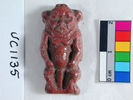Bes


He was particularly protective of women and children and was often depicted with the young HorusNew Kingdom he was a regular feature of the illustrations on the walls of the mammisi ("birth house"). protecting him as he matured. As a result, he also became a god of childbirth. It was thought that he could scare off and evil spirits lurking around the birthing chamber by dancing, shouting and shaking his rattle. If the mother was experiencing a difficult birth, a statue of Bes was placed near her head and his assistance was invoked on her behalf. Rather sweetly, Bes remained at the child´s side after birth to protect and entertain them. It was said that if a baby laughed or smiled for no reason, it was because Bes was pulling funny faces. By the
Bes also drove away the evil spirits who caused accidents and created mischief (just as mediaeval gargoyles were thought to scare evil spirits away from churches). Many Egyptians placed a statue of Bes near the door of their house to protect them from mishap. His protection could also be invoked by tattooing his image directly onto the body. Performers often had tattoos of Bes because of his association with dancing and music. It is also thought that sacred prostitutes may have had a tattoo of Bes placed near their pubic area in order to prevent venereal diseases, but it is also possible that the tattoos related to fertility.
It is often suggested that he was not a god of Egyptian origin, instead being imported from Africa during the Middle Kingdom. Certainly Bes was described in inscription as "Coming from the Divine Land" and was known as the "Lord of Punt". However, he is also mentioned in records found in Upper Egypt dating to the Old Kingdom suggesting that he may well be Egyptian, but that his worship was not widespread until the New Kingdom. At present there is insufficient evidence regarding his origins to be sure either way.
 | Archeologists have recovered numerous Bes masks and costumes dating from the New Kingdom. It is thought that these saw regular use and so they may have been the property of professional entertainers. At this point in history he was often linked to Tawret (another demon-deity who offered protection during labour). In fact, he was thought to be her husband until the Ptolemaic Period.They were so popular with the common people that amulets of both Bes and Tawret's were found even at Akhetaten (the city of Akenaten) despite the replacement of many of the other gods by The Aten. |
Bes was also associated with a number of the more powerful gods; including Amun, Min, Horus and Reshep. He was most often associated with Horus the child. Bes often appeared on amulets and stele depicting the young horus and inscriptions intended to protect against snake bites etc (known as "cippi").The two gods also formed the composite deity "Horbes", even although Beset (Bes´ wife during the Ptolemaic Period) was also described as Horus´ mother! Bes was also closely associated with Hathor, who was also described as the mother or wife of Horus. The goddess was known as the "Lady of Punt", and was also a goddess of childbirth, dancing and music who shared many iconographic symbols with Bes.
Bes was generally depicted as a bearded dwarf, sticking out his tongue and shaking a rattle. He is always depicted facing forwards. This was very rare in Egyptian art and gave him a further link with Hathor who also faces the front. However, unlike the simple beauty of that goddess, Bes is a comical figure with pronounced bow legs, prominent genitals and a tail. He usually wears a plumed crown and the lion or panther skin associated with the "stm" priests. Occassionally he wears the Atef crown and is depicted as a winged deity. There are also a number of amulets and depictions of Bes which only show his head (still facing the front), although most of these date from the Third Intermediate Period or later.
Bes was sometimes depicted with feline or leonine features and often sports a long tail prompting the speculation that in earlier times, he was not in fact a dwarf but a lion or cat rearing up on his hind legs. If he did start out as a feline goddess this would give him a further link to Hathor who was herself very closely associated with Bast (a cat goddess) and Sekhmet (a lion goddess) and the "Eye of Ra" (the fearsome protector of Ra). Furthermore, his name may be derived from the Nubian word for cat ("besa") and is written using the determinative for a mammal rather than the determinative of a god or a man (the cow skin). It is equally likely that he was always seen as a dwarf with the strength and power of a cat.
http://en.wikipedia.org/wiki/Aha
Aha
god protecting women and children at birth (his name means 'Fighter'). Main deity in the Middle Kingdom at Khemenu/Ashmunein (UE15) - later named Bes and widespread as childbirth protector but not as a principal temple god
 | Bes figure, found at Amarna (click on the image for a larger picture |












No comments:
Post a Comment